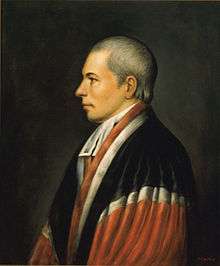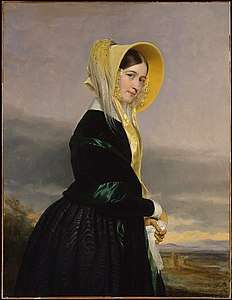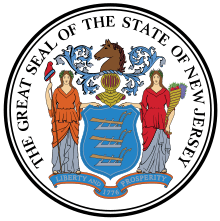William Paterson (judge)
William Paterson (December 24, 1745 – September 9, 1806) was a New Jersey statesman and a signer of the United States Constitution. He was an Associate Justice of the United States Supreme Court and the second governor of New Jersey.
William Paterson | |
|---|---|
 | |
| Associate Justice of the Supreme Court of the United States | |
| In office March 4, 1793 – September 9, 1806 | |
| Nominated by | George Washington |
| Preceded by | Thomas Johnson |
| Succeeded by | Henry Livingston |
| 2nd Governor of New Jersey | |
| In office October 29, 1790 – March 30, 1793 | |
| Preceded by | Elisha Lawrence (Acting) |
| Succeeded by | Thomas Henderson (Acting) |
| United States senator from New Jersey | |
| In office March 4, 1789 – November 13, 1790 | |
| Preceded by | Seat established |
| Succeeded by | Philemon Dickinson |
| Attorney General of New Jersey | |
| In office 1776–1783 | |
| Governor | William Livingston |
| Preceded by | Position established |
| Succeeded by | Joseph Bloomfield |
| Personal details | |
| Born | December 24, 1745 County Antrim, Ireland (now United Kingdom) |
| Died | September 9, 1806 (aged 60) Albany, New York, U.S. |
| Political party | Federalist |
| Spouse(s) | Cornelia Bell
( m. 1779; died 1783)Euphemia White
( m. 1785; |
| Education | Princeton University (BA, MA) |
Born in County Antrim, Ireland, Paterson moved to the North American British colonies at a young age. After graduating from the College of New Jersey (now Princeton University) and studying law under Richard Stockton, he was admitted to the bar in 1768. He helped write the 1776 Constitution of New Jersey and served as the New Jersey Attorney General from 1776 to 1783. He represented New Jersey at the 1787 Philadelphia Convention, where he proposed the New Jersey Plan, which would have provided for equal representation among the states in Congress.
After the ratification of the Constitution, Paterson served in the United States Senate from 1789 to 1790, helping to draft the Judiciary Act of 1789. He resigned from the Senate to take office as Governor of New Jersey. In 1793, he accepted appointment by President George Washington to serve as an Associate Justice of the Supreme Court. He served on the court until his death in 1806.
Early life
William Paterson was born December 24, 1745, in County Antrim, Ireland, to Richard Paterson, an Ulster Protestant.[1] Paterson immigrated with his parents to New Castle, Pennsylvania, in 1747.[2] At 14, he began college at Princeton. After graduating, he studied law with the prominent lawyer Richard Stockton and was admitted to the bar in 1768. He also stayed connected to his alma mater and helped found the Cliosophic Society with Aaron Burr.[3]
Career
Early career
Paterson was selected as the Somerset County delegate for the first three provincial congresses of New Jersey, where, as secretary, he recorded the 1776 New Jersey State Constitution.[4] After Independence, Paterson was appointed as the first Attorney General of New Jersey, serving from 1776 to 1783, maintaining law and order and establishing himself as one of the state's most prominent lawyers.[5] He was sent to the 1787 Philadelphia Convention in Philadelphia, Pennsylvania where he proposed the New Jersey Plan for a unicameral legislative body with equal representation from each state. After the Great Compromise (for two legislative bodies: a Senate with equal representation for each state, and a House of Representatives with representation based on population), the Constitution was signed.[4]
United States Senator
Paterson, who was a strong nationalist who supported the Federalist party, went on to become one of New Jersey's first U.S. senators (1789–90).[4] As a member of the Senate Judiciary Committee, he played an important role in drafting the Judiciary Act of 1789 that established the federal court system.[4] The first nine sections of this very important law are in his handwriting.[6]
Governor of New Jersey
In 1790, he became the first person ever to resign from the U.S. Senate, when he did so in order to succeed fellow signer William Livingston as governor of New Jersey.[4] As governor, Paterson pursued his interest in legal matters by codifying the English statutes that had been in force in New Jersey before the Revolution in Laws of the State of New Jersey. He also published a revision of the rules of the chancery and common law courts in Paterson, later adopted by the New Jersey Legislature.[6][5]
United States Supreme Court
President George Washington nominated Paterson for the Supreme Court of the United States on February 27, 1793, to the seat vacated by Thomas Johnson. Washington withdrew the nomination the following day, having realized that since the Judiciary Act of 1789 (the law creating the Supreme Court) had been passed during Paterson's current term as a Senator, the nomination was a violation of the Ineligibility Clause (Article I, Section 6) of the Constitution. Washington re-nominated Paterson to the Court on March 4, 1793, after his term as Senator had expired; Paterson was immediately confirmed by the Senate and received his commission.[7]
He resigned the governorship to become an associate justice of the U.S. Supreme Court (1793–1806). On circuit he presided over the trials of individuals indicted for treason in the Whiskey Rebellion, a revolt by farmers in western Pennsylvania over the federal excise tax on whiskey, the principal product of their cash crop. Militia sent out by President Washington successfully quelled the uprising, and for the first time the courts had to interpret the provisions of the Constitution with regard to the use of troops in civil disturbances. Here, and in fact throughout his long career, Paterson extolled the primacy of law over governments, a principle embodied in the Constitution he helped write.[8] He declined an appointment as Secretary of State in 1795. He was elected a Fellow of the American Academy of Arts and Sciences in 1801.[9]
Paterson served on the Supreme Court until his death in 1806.[4]
Personal life
_MET_DP168948_(cropped).jpg)

In 1779, Paterson married to Cornelia Bell (1755–1783), daughter of John Bell, a wealthy Somerset County Landowner.[10][4] Together, they had three children, but she died in 1783 shortly after giving birth to their only son:
- Cornelia Bell Paterson (1780–1844), who married Stephen Van Rensselaer (1764–1839) after the death of his first wife, Margaret "Peggy" Schuyler (1758–1801)[11]
- Frances Van Paterson (1781–1783), who died young[12]
- William Bell Paterson (1783–1832), who married Jane Eliza Neilson[12][6]
In 1785, he married Euphemia White (1746–1832),[10] sister of Anthony Walton White (1750–1803), daughter of Anthony White (1717–1787), a New Jersey landholder and judge of the Somerset court, and the granddaughter of Lewis Morris (1671–1746), Chief Justice of New York from 1715 to 1733 and Governor of New Jersey from 1738 to 1746.[13][14]
Death and interment
On September 9, 1806, Paterson, aged 60, died from the lingering effects of a coach accident suffered in 1803 while on circuit court duty in New Jersey. He was on his way to the spa at Ballston Springs, New York, to "take the waters", when he died at the Van Rensselaer Manor home of his daughter, Cornelia, and son-in-law, Stephen Van Rensselaer, in Albany, New York. He was laid to rest in the Van Renssalaer family vault. When the city acquired the property, Paterson's remains were relocated to Albany Rural Cemetery Menands in Albany County, New York. Also buried there are Associate Justice Rufus W. Peckham and President Chester A. Arthur.[15][16]
Descendants
Through his eldest daughter, his grandchildren included Cortlandt Van Rensselaer (1808–1860), a noted Presbyterian clergyman,[11] and Henry Bell Van Rensselaer (1810–1864), a politician and general in the Union Army during the American Civil War, who married Elizabeth Ray King, a granddaughter of U.S. Senator Rufus King.[11]
Through his son, his grandchildren included twin brothers, William Paterson (1817–1899), who married Salvadora Meade, a Spanish-born woman living in Philadelphia,[17] and Stephen Van Rensselaer Paterson (1817–1872),[18] who married Emily Sophia King (1823–1853), daughter of Charles King (1789–1867), the president of Columbia University, and the second son Rufus King. Both grandsons were members of the Princeton University class of 1835 and William was admitted to the bar in 1838. He later served as a member of the New Jersey Assembly from 1842 to 1843, Secretary of the New Jersey Constitutional Convention of 1844, a lay judge of the Court of Errors and Appeals, and mayor of Perth Amboy for ten years in between 1846 and 1878.[18]
Honors
Both the city of Paterson, New Jersey, and the college, William Paterson University, are named after him.[4]
See also
- Demographics of the Supreme Court of the United States
- List of Justices of the Supreme Court of the United States
- List of U.S. Supreme Court Justices by time in office
- United States Supreme Court cases during the Jay, Rutledge and Ellsworth Courts
- United States Supreme Court cases during the Marshall Court
- U.S. Constitution, floor leader in Convention.
- List of United States Senators born outside the United States
- List of U.S. state governors born outside the United States
References
- McCarthy, Joseph F. X. (1999). "The Constitution of the United States". In Glazier, Michael (ed.). The Encyclopedia of the Irish in America. Notre Dame, IN: University of Notre Dame Press. p. 185. ISBN 978-0268027551.
[Thomas Fitzsimons] was one of the two Catholic delegates to the Convention (Daniel Carroll was the other).
- "PATERSON, William - Biographical Information". Biographical Directory of the United States Congress. United States Congress.
- "Daily Princetonian Special Class of 1991 Issue 27 July 1987 — Princeton Periodicals". princeton.edu.
- Vile, John R. (October 10, 2013). The Men Who Made the Constitution: Lives of the Delegates to the Constitutional Convention. Scarecrow Press. ISBN 9780810888654. Retrieved February 21, 2017.
- Haskett, Richard C. (1950) William Paterson, Attorney General of New Jersey: Public Office and Private Profit in the American Revolution. William and Mary Quarterly, 3rd. Ser., 7 (January): pp. 26–38.
- O'Connor, John E., William Paterson: Lawyer and Statesman, 1745–1806 (New Brunswick, N.J.: Rutgers University Press, 1979), pp. 108, 117.
- Myers, Gustavus (1912). History of the Supreme Court of the United States. C. H. Kerr. p. 149. Retrieved February 21, 2017.
- Wright Jr., Robert K.; MacGregor Jr., Morris J. (1987). Soldier-Statesmen of the Constitution. Washington, D.C.: U.S. Army Center of Military History. p. 166. LCCN 87001353. Retrieved July 28, 2014.
- "Book of Members, 1780–2010: Chapter P" (PDF). American Academy of Arts and Sciences. Retrieved July 28, 2014.
- Epstein, Lee; Segal, Jeffrey A.; Spaeth, Harold J.; Walker, Thomas G. (July 29, 2015). The Supreme Court Compendium: Data, Decisions, and Developments. CQ Press. ISBN 9781483376639. Retrieved February 21, 2017.
- Reynolds, Cuyler (1914). Genealogical and Family History of Southern New York, Volume 3. New York: Lewis Publishing Company. pp. 1166, 1341.
- Wood, Gertrude Sceery, William Paterson of New Jersey, 1745–1806 (Fair Lawn, N.J.: Fair Lawn Press, 1933), pp. 49, 199.
- Marcus, Maeva (1985). The Documentary History of the Supreme Court of the United States, 1789–1800. Columbia University Press. ISBN 9780231088695. Retrieved February 21, 2017.
- Lefferts, Elizabeth Morris, comp., Descendants of Lewis Morris of Morrisania (New York: Tobias A. Wright, 1907).
- Christensen, George A. "Here Lies the Supreme Court: Gravesites of the Justices". Yearbook 1983 Supreme Court Historical Society. Washington, D.C.: Supreme Court Historical Society (1983): 17–30. Archived from the original on September 3, 2005. Retrieved June 5, 2018 – via Internet Archive.
- See also, Christensen, George A. (February 2008). "Here Lies the Supreme Court: Revisited". Journal of Supreme Court History. Blackwell Publishing. 33 (1): 17–41. doi:10.1111/j.1540-5818.2008.00177.x. eISSN 1540-5818. ISSN 1059-4329.
- Bond, Gordon. "To Cast A Freedman's Vote: How a Handyman from Perth Amboy Made Civil Rights History" (PDF). metuchen-edisonhistsoc.org. Retrieved February 21, 2017.
- "Manuscript Group 718, William Paterson (1817–1899), Student and author". www.jerseyhistory.org. The New Jersey Historical Society. Retrieved February 21, 2017.
Further reading
- Abraham, Henry J. (1992). Justices and Presidents: A Political History of Appointments to the Supreme Court (3rd ed.). New York: Oxford University Press. ISBN 0-19-506557-3.
- Bibliography on William Patterson at Supreme Court Historical Society.
- Cushman, Clare (2001). The Supreme Court Justices: Illustrated Biographies, 1789–1995 (2nd ed.). (Supreme Court Historical Society, Congressional Quarterly Books). ISBN 1-56802-126-7.
- Flanders, Henry. The Lives and Times of the Chief Justices of the United States Supreme Court. Philadelphia: J. B. Lippincott & Co., 1874 at Google Books.
- Frank, John P. (1995). Friedman, Leon; Israel, Fred L. (eds.). The Justices of the United States Supreme Court: Their Lives and Major Opinions. Chelsea House Publishers. ISBN 0-7910-1377-4.
- Hall, Kermit L., ed. (1992). The Oxford Companion to the Supreme Court of the United States. New York: Oxford University Press. ISBN 0-19-505835-6.
- Martin, Fenton S.; Goehlert, Robert U. (1990). The U.S. Supreme Court: A Bibliography. Washington, D.C.: Congressional Quarterly Books. ISBN 0-87187-554-3.
- Urofsky, Melvin I. (1994). The Supreme Court Justices: A Biographical Dictionary. New York: Garland Publishing. p. 590. ISBN 0-8153-1176-1.
- Warren, Charles. (1928) The Supreme Court in United States History, 2 vols. at Google books.
- Wright, Robert K.; MacGregor Jr., Morris J. (1987). "William Paterson". Soldier-Statesmen of the Constitution. United States Army Center of Military History. CMH Pub 71-25.
External links
| Wikimedia Commons has media related to William Paterson (judge). |
- United States Congress. "William Paterson (id: P000102)". Biographical Directory of the United States Congress.
- William Paterson at the Biographical Directory of Federal Judges, a public domain publication of the Federal Judicial Center.
- New Jersey Governor William Paterson, National Governors Association
- Oyez Project, U.S. Supreme Court media, William Paterson.
| Legal offices | ||
|---|---|---|
| New office | Attorney General of New Jersey 1776–1783 |
Succeeded by Joseph Bloomfield |
| Preceded by Thomas Johnson |
Associate Justice of the Supreme Court of the United States 1793–1806 |
Succeeded by Henry Livingston |
| U.S. Senate | ||
| Preceded by New seat |
U.S. senator (Class 2) from New Jersey 1789–1790 Served alongside: Jonathan Elmer |
Succeeded by Philemon Dickinson |
| Political offices | ||
| Preceded by Elisha Lawrence Acting |
Governor of New Jersey 1790–1793 |
Succeeded by Thomas Henderson Acting |




